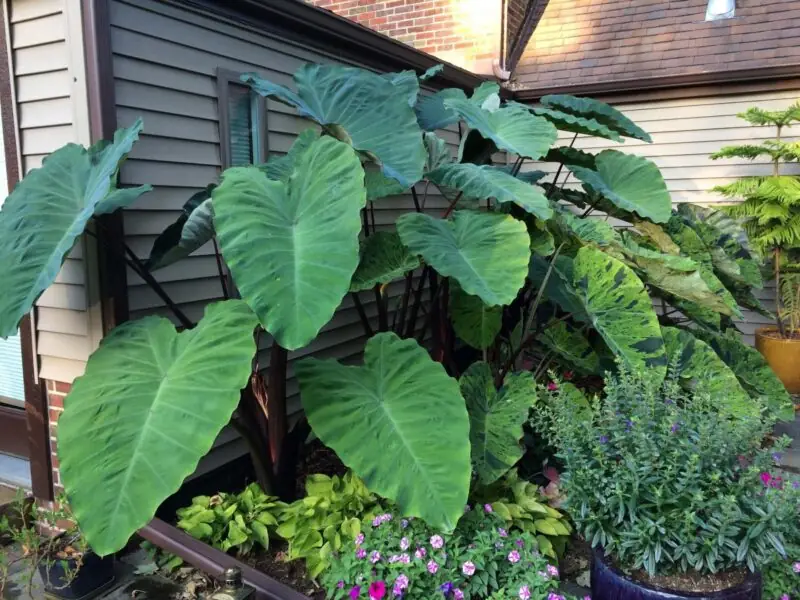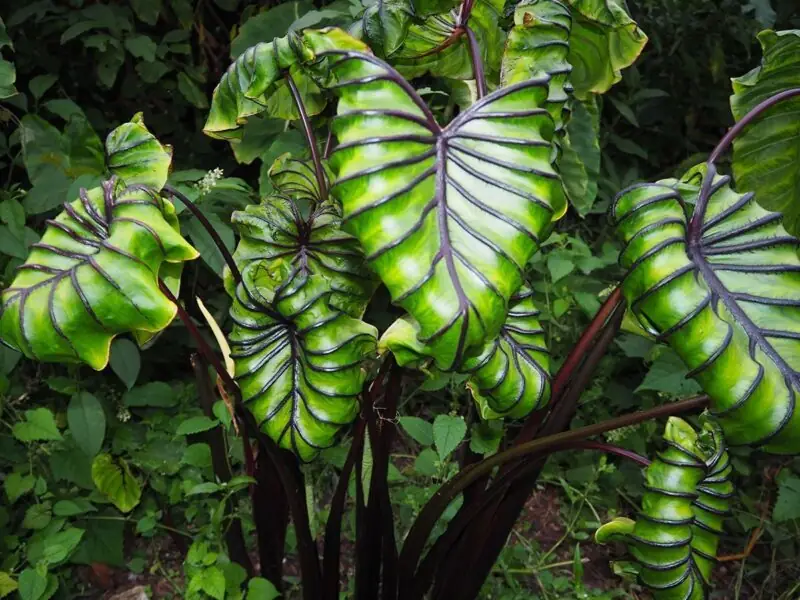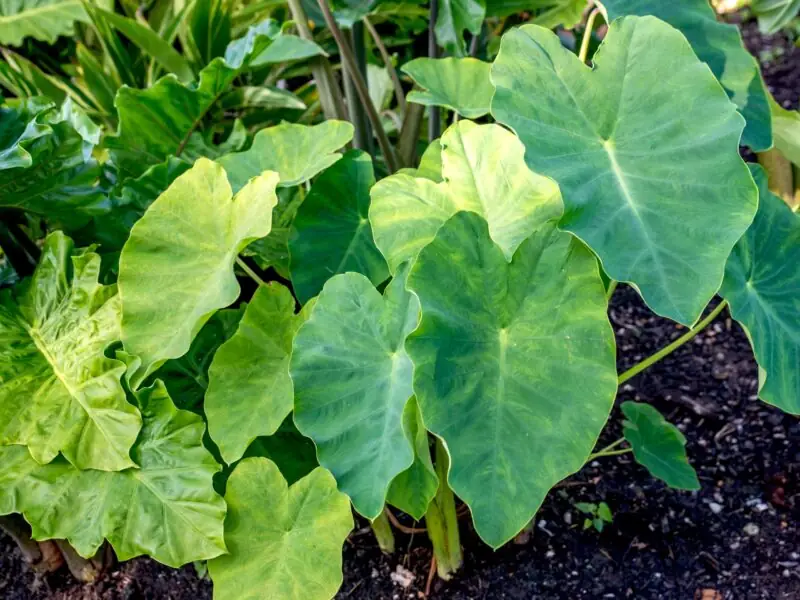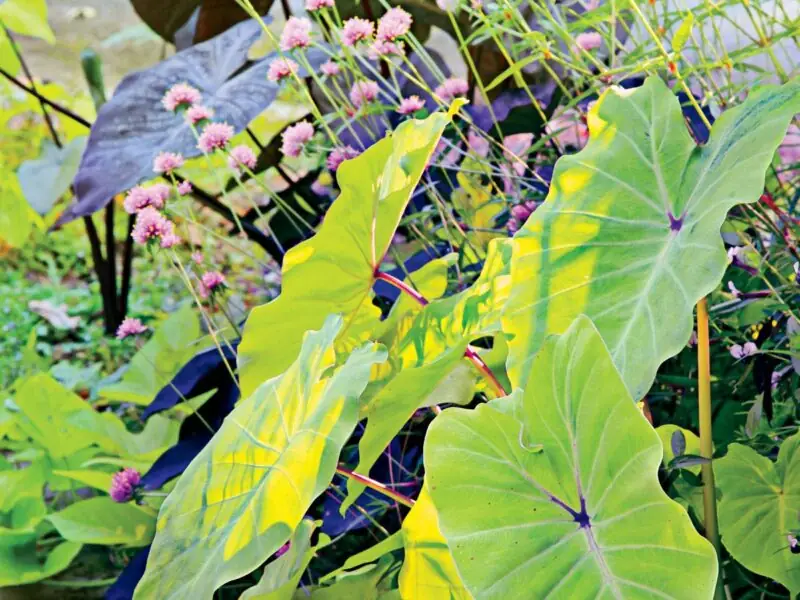8 Reasons Why Elephant Ear Plant Leaves Drooping and Turning Yellow

Are you a tropical plant enthusiast? Then you might have noticed the enchanting elephant ear plant. With large, wide leaves reminiscent of an elephant’s ears, this plant is both exotic and striking. Like all living things, it needs proper care to flourish.
A common challenge that gardeners face when caring for the elephant ear plant is drooping and yellowing leaves. This article explores the causes of these issues and provides preventative measures.
Understanding This Unique Plant
The elephant ear plant, scientifically known as Alocasia, is intriguing. The name “Alocasia” is derived from “Colocasia,” that comes from the Latin and Greek words for the East Indian Lotus. This plant shares the Araceae family with other popular houseplants like the Peace Lily, Pothos, and Philodendron. Its natural habitat is primarily Southeast Asia.
The plant boasts broad, arrowhead-shaped big leaves. These leaves sprout on long stems, directly connected to underground rhizomes. Each leaf resembles an upturned heart, measuring between 1 to 4 feet long, depending on the species or cultivar.
While some varieties may produce white flowers during the late summer season, these are rarely seen indoors due to low light conditions. The elegant plants come in different shades and patterns, including green-yellow-white striped edges, making them perfect statement pieces for homes.
The Role of Healthy Leaves
Healthy leaves are crucial for the survival and growth of the plants. These leaves photosynthesize nutrients needed for the plant’s health. They also provide the energy necessary for food production through chlorophyll.
If there isn’t enough chlorophyll, the plant appears lackluster. This can cause stress, leading to further damage. Therefore, it’s vital to provide the right growing conditions. These include proper water, light, and nutrient balance.

Recognizing Signs of Stress in the Plants: Drooping and Yellow Leaves
Drooping leaves can result from several factors. A common cause of drooping elephant ear leaves is inadequate water or overwatering. Both situations stress the roots, causing dehydration, which in turn leads to leaf wilting. If the plant doesn’t receive enough water, the moisture levels drop, causing the plant to lose turgor pressure. This is necessary for supporting the plant’s structure, and its loss can lead to stem collapse.
Yellowing leaves often result from improper sunlight exposure. This affects photosynthesis, resulting in insufficient chlorophyll production. This is vital for the plant’s metabolic functions.
The Plant Life Cycle
Normal Growth Cycle of Elephant Ear Plants
These plants have a natural growth cycle, with some variations depending on the species. Each spring, the rhizomes begin producing new shoots. Older ones die back after the flowering season ends. This marks the start of summer when long stems unfurl into large, heart-shaped green leaves. This growth continues until fall, then the plant enters a dormant phase to prepare for the next year’s season.
Natural Yellowing of Elephant Ear Leaves
Yellowing of the plant leaves naturally occurs at certain times during their lifecycle. This mainly happens towards the end of fall before the dormant period. While it might seem alarming at first, it’s a normal physiological response to environmental changes. The plant sheds old foliage to prepare for new growth in the upcoming seasons. This process doesn’t harm the plant’s overall health. The plant sends the nutrients stored within these parts to underground structures for future use.
Understanding Elephant Ear Leaf Drooping in its Life Cycle
If your plant’s leaves droop occasionally, don’t fret! This often happens during extreme hot weather conditions. High temperatures can cause a temporarily wilted appearance, but the plant usually recovers after nightfall. Similarly, if the plant receives too much water or if humidity levels are high, the leaves may droop. This is a normal response as the plant adjusts to its environment.

The Impact of Temperature
The Ideal Temperature for Growing Elephant Ears
These plants thrive in warmer temperatures between 65°F-80°F (18°C-27°C). They also appreciate consistent airflow to regulate temperature and humidity. Whether grown outdoors in garden beds or indoors in pots, the ideal temperature range remains the same.
The Effects of Cold: Yellow Leaves and Drooping
Cold weather can severely impact elephant ear plants. It can cause yellowing and leaf drop, especially when the plant is exposed to frost for prolonged periods. It’s best to avoid planting outdoors until the risk of freezing is over in the spring season. When growing indoors, ensure there’s adequate insulation around the pot to prevent root damage from sudden temperature drops.
If your plant starts turning yellow during cold spells, move it to a warm room immediately. Also, avoid placing it near windows or doors where drafts could cause further harm.
The Impact of Heat: When Plants Turn Yellow
Heat stress can lead to wilting and even death in elephant ear plants. Signs of heat stress become apparent when ambient temperatures reach above 90 degrees F (32°C). To prevent heat damage, provide shade and allow ample airflow around the plant. Also, ensure sufficient watering to maintain the turgor pressure necessary for the plant to stay upright and not wilt.
The Impact of Sunlight on The Plants

Ideal Sunlight Conditions for Growing Healthy
Proper light exposure plays a critical role in maintaining the health and vibrant growth of elephant ear plants. These plants thrive under bright but indirect sunlight, making them a perfect choice for adding a unique splash of greenery to your interiors. While they appreciate natural daylight, they need protection from direct UV rays, which can scorch their sensitive leaves.
Try positioning potted the plant near east-facing windows. This provides them with early morning sun and indirect light throughout the day. If your home lacks sufficient lighting, consider investing in grow lights to supplement existing natural light sources.
The Consequences of Too Much Sun: Yellow Leaves
Elephant ear plants exposed to direct sunlight may scorch their leaves. This can cause them to turn yellow and brown, and can even permanently damage the foliage. To keep your plant healthy, avoid placing them where they’ll be exposed to direct sun for prolonged periods.
The Impact of Insufficient Light: Leaf Drooping and Yellowing
Insufficient light can also cause leaf drooping or a yellowed appearance. These plants require bright, indirect daylight. This keeps chlorophyll production high and promotes overall healthy growth. If you notice a pale green-yellowish color on the lower side of the foliage, it’s time to relocate the plant to a spot with more sunshine during the daytime hours.
The Effect of Watering on Elephant Ear Plants
Watering Needs of The Plant in Pots
Overwatered elephant ears are susceptible to root rot. This can lead to further complications down the line. The roots can’t absorb the oxygen they need for respiration when there’s standing water in the soil. Even with enough moisture from excessive watering, the plants may wilt. This is why proper drainage is essential, especially indoors where there’s no natural drying out period between waterings.
Overwatering: A Common Cause of Yellow, Drooping Leaves
A common reason for yellow, drooping leaves is overwatering. Waterlogging occurs when excessive moisture accumulates around the roots. This forms an anaerobic environment that inhibits nutrient uptake. It leads to impaired metabolic functions and a lackluster appearance, among other issues.
Underwatering and Its Impact: Wilting The Plants
Underwatered elephant ear plants tend to wilt. They show symptoms similar to overwatered plants, but with distinct differences. Underwatering can lead to partial or complete dehydration, causing the leaves to turn yellow. Without prompt attention, the plant may not recover. To avoid this, ensure a sufficient watering schedule. These plants prefer moist, not wet, soil. Keep the top inch of soil damp (but not soaked) between waterings.
The Role of Soil Conditions in Caring for Elephant Ears
The Importance of Soil Conditions for Healthy Plants
Soil composition plays a critical role in helping the plants thrive. They require well-draining potting mixtures rich in organic matter. These mixtures retain water while still allowing adequate airflow around the roots.
Choose substrates enriched with nutrients like composted manure. Mix in perlite or vermiculite to improve drainage and aeration.
The Effects of Poor Soil Conditions: Yellow Leaves on The Plants
Poor soil conditions can cause numerous issues, including poor nutrient uptake and low oxygen availability due to compaction. Improper pH levels can lead to micronutrient deficiencies, resulting in a lackluster appearance and other symptoms such as wilting, drooping stems, and yellow foliage. Regularly monitor and amend the soil to provide the perfect growing medium.
Adjusting Soil Conditions to Prevent Yellowing Elephant Ear Leaves
Adjusting the soil’s pH level can help prevent many problems associated with poor soil conditions. Aim for acidic soil with a pH range of 5.8 to 6.8 for your elephant ears. This encourages efficient nutrient uptake and supports the plant’s metabolic processes throughout its life cycle. Proper soil adjustment can effectively prevent the leaves of your elephant ears from turning yellow.
Nutrient Deficiencies Leading to Yellow Leaves in Elephant Ear Plants
The plants are heavy feeders that require ample nutrition for vigorous foliage production. Selecting the right fertilizer is essential for promoting proper vegetative growth and ensuring resilience against environmental stressors over time. Utilize balanced, slow-release formulations high in nitrogen to encourage lush greenery development, while avoiding excessive use of salts that can burn the plant’s foliage and roots.
The Nutritional Requirements of Elephant Ear Plants
In addition to the fundamental macronutrients – nitrogen, phosphorus, and potassium — these plants require trace elements, including magnesium, iron, and manganese, to ensure proper metabolic functions throughout their life cycle. Organic fertilizers such as fish emulsion or seaweed extracts can meet these needs, helping to keep your plants happy and healthy!
Nutrient Deficiencies: A Reason Why Elephant Ear Leaves Turn Yellow
Nutrient deficiencies are a common cause of yellowing leaves in these plants. These plants require specific nutrients, including nitrogen, phosphorus, potassium, calcium, magnesium, and iron, to grow healthy and strong. If your plant isn’t receiving these essential nutrients from the soil or the fertilizer you’re providing, its leaves may start to turn yellow due to chlorophyll deficiency.
Using Fertilizers to Prevent Yellow Leaves and Leaf Drooping
Fertilizing your plant is crucial for its care, providing the necessary nutrients for healthy growth. When choosing a fertilizer, select one that has balanced amounts of nitrogen, phosphorus, and potassium. Nitrogen promotes leafy growth, phosphorus encourages root development and flowering, and potassium helps plants absorb other vital nutrients from the soil. Apply the fertilizer correctly by following these steps:
- Dilute the recommended amount according to package instructions.
- Apply it to moist soil about 6 inches away from the stem or base.
- Gently work it into the top layer with your fingers or a rake.
- Water thoroughly after application.
Over-fertilization can lead to burnt roots, causing yellow leaves on Elephant Ear Plants. Therefore, caution is advised.
Root Health: An Underlying Factor in Elephant Ear Leaf Health
The roots of an elephant ear plant are crucial as they absorb the water and nutrients needed by all above-ground parts, including the leaves. Root damage may occur due to various reasons, such as pests like spider mites, or indirectly through poor drainage leading to root rot, which causes yellowing and drooping symptoms in the foliage above ground level.
The Significance of Healthy Roots for Elephant Ears
Healthy roots support sturdy stems and large, lush green leaves that exude tropical vibes even when indoors. To maintain healthy roots, follow these steps:
- Choose a well-draining potting mix, preferably one containing perlite.
- Avoid heavy clay soils.
- Use pots with drainage holes.
- Water properly, keeping in mind the specific needs of different species—some require more frequent watering than others.
Root Rot: When Elephant Ear Leaves Yellow and Droop
Root rot is a condition that arises from excessive moisture in the soil, leading to a lack of oxygen for the roots. This causes them to rot, turn brown or black, and become mushy. Early warning signs of root rot include leaves that droop and do not perk up after watering, yellowing foliage, and an unpleasant odor emanating from the soil.
Remedies for Root Damage in Elephant Ear Plants
If you suspect root damage or rot, follow these steps:
- Remove your plant from its pot.
- Inspect the roots—healthy ones appear firm and white or green, while damaged roots appear dark, brown, or soft.
- Trim away any soft, dead, or damaged parts using sterilized scissors or pruners.
- Repot the plant using a fresh, well-draining mix—preferably one containing perlite—into a clean container with drainage holes.
Acclimation of Elephant Ear Plants
Elephant ear plants require acclimation, whether they are grown indoors before being moved outside or vice versa. The acclimation process involves gradually exposing the plant to new conditions, such as temperature changes and sunlight intensity, to prevent stress symptoms such as leaf drop, drooping, or yellowing.
Understanding the Acclimation Process in Elephant Ears
The best acclimation method involves gradually moving the plant outdoors for increasing durations each day over a period of 7-10 days until it can fully withstand outdoor conditions. If moving the plant indoors, follow this process in reverse order, beginning in low-light areas!
Acclimation Symptoms: Elephant Ear Leaves Drooping and Turning Yellow
During acclimation, elephant ears may exhibit symptoms such as wilting stems and yellow leaves. This can occur due to insufficient water being absorbed through the roots, as plant growth slows down during transition periods.
Caring for Elephant Ears During Acclimation
To properly care for your elephant ear plant during this critical adjustment period, ensure it receives the right amount of sun or shade according to its species’ needs (some prefer less direct sunlight). Also, maintain a consistent moisture level (neither too wet nor dry) and avoid fertilizing until the plant has fully acclimated to its new conditions.
FAQs About Elephant Ear Leaves Drooping and Turning Yellow
Yellowing leaves can result from various factors, including too much or too little water, improper light levels, nutrient deficiencies or overdoses, pests, and diseases. First, assess your watering habits, then consider other potential issues if the problem persists.
Elephant ear leaves may droop if their roots are damaged (for example, from over-watering), if they’re not receiving enough sun, light exposure, nutrients, fertilizer, or if they’re experiencing extreme temperature fluctuations.
Reviving a dying elephant ear plant depends on identifying the root cause of its decline. Adjust your watering schedule if under or over-watering is the issue. Repotting might also help if the soil is depleted or nutrient-poor. If your plants have been exposed to cold temperatures for prolonged periods, consider moving them indoors where it’s warmer, allowing them to recover before being moved back outside in the springtime.
Yes! In most cases, yellowed foliage will return to green once the underlying issues causing the discoloration—such as nutritional deficiencies, inadequate lighting, or improper moisture levels—are addressed.
Conclusion
Caring for an elephant ear plant requires understanding its specific needs regarding sunlight, water, space requirements, and potential health-affecting factors such as pest infestations, root rot, and diseases. These conditions can lead to symptoms like leaf drop, yellowing, and drooping. By following the tips outlined above, you’ll be able to provide your tropical beauty with the necessary care, ensuring lush greenery year-round, free from stress-induced damage due to poor growing conditions.